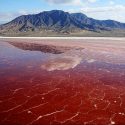When it rains, it pours, but you’ve never seen anything like this. It’s been raining for weeks on end. The streets have stopped draining and you’re seeing the water creep toward your house. It’s not going to be long before it comes through the front door and destroys everything inside. A megaflood happens when lengthy superstorms overwhelm rivers and infrastructure, destroying everything in their path.
And no, this isn’t some apocalyptic movie plot. Thanks to climate change this is becoming more likely. In some regions, the odds of this happening right now are 1 in 50. If the level of the world’s production of greenhouse emissions continues over the next 40 years, the chances of a megaflood will increase by 374%. What U.S. state is at highest risk? What should you do if you’re stuck in your car during the flood? And how would you know when to evacuate?
Step 1. Stay Away From California
The Golden State’s blue skies will soon turn grey and you better be prepared for it. Based on two models, scientists have theorized how California would be affected by a megaflood. According to a historical model, a megaflood could fill the Sierra Nevada mountain range with more than 2 m (6.5 ft) of water. In other parts of the state, heavy rainfall would follow this for at least a month. The rainfall would freeze on mountain peaks, eventually leading to a massive runoff to lower elevations and overflowing rivers.
Step 2. Pack Your Bags
If you live in a coastal town or a flood-prone area, be prepared. Make sure to regularly look at the Emergency Alert System (EAS) and the National Oceanic and Atmospheric Administration (NOAA). Have a bag of supplies ready to go at any time. You’ll need non-perishable food, water for several days and phone chargers.
Step 3. Evacuate
Following the news can be a bit boring, but during a superstorm, it can save your life. They’ll let you know when it’s time to evacuate. And when you do, follow the instructions provided by state officials. They’ll make sure you can avoid added risks like collapsing bridges or fast-moving water. No matter how bad the increased traffic gets or how desperate you’re feeling, driving around barricades can put you in a much worse position.
Step 4. Get to the Roof
Everyone in your area is following the same evacuation plan as you, and the roads are packed with vehicles. The water has reached your car and rising fast. You need to get out of the car, but don’t try to walk or swim. You could be hit by debris and drown. Get on the roof of your vehicle and keep your eyes on social media for alerts and updates. Wait for information about what you should do, or if there are emergency crews on the way.
Step 5. Clean Up
When it’s finally safe to return home, keep in mind that it could be destroyed. Flood waters can introduce dangerous bacteria and mold into your home. Wear protective clothes, boots and masks when handling your damaged property. If you have any respiratory issues, like asthma, you better stay away from there.
Sources
- Why the ‘Big One’ Could Be Something Other Than an Earthquake. Zhong, R. (2022). The New York Times.
- A disastrous megaflood could bring more than 8 feet of water to parts of California, scientists say. Cohen, L. (2022). CBS News.
- Climate change is increasing the chances of a California ‘megaflood,’ experts warn. Da Silva, C. (2022). NBC News.
- How Is Climate Change Affecting Floods? Shao, E. (2022). The New York Times.
- Climate change is increasing the risk of a California megaflood. Huang, Z. and Swain, D. (2022). Science Advances.

















